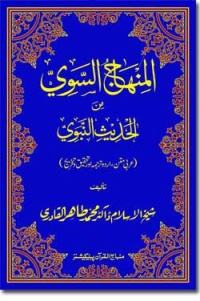Difference between revisions of "AlMinhaj usSawi"
m (moved Minhaj us Sawi to AlMinhaj usSawi) |
|
(No difference)
| |
Revision as of 09:45, 26 October 2013
Al-Minhaj us-Sawi min-al-Hadith-in-Nabawi is a Hadith compendium compiled by Shaykh ul Islam Dr. Muhammad Tahir ul Qadri. It is compiled in the pattern and style of Imam Nawawi’s Riyadh as-Saaliheen رياض الصالحين and Khatib Tabrizi’s Mishkat al-Masabih It is a compendium of Prophetic Hadiths, categorised under a number of headings and compiled with clear relevance to the lives and situation of Muslims in the modern age. The work is authenticated by a rigorous and detailed process of Takhreej – referencing each hadith to its sources – from a study of over 300 authentic works of hadith.
The writer has set up 16 chapters of the book including an abridged version of his chains of authorities (Mukhtasar al-Jawahir al-Bahira fi al-Asanid at-Tahira) and a firm word on the science of hadith and branches of doctrine which is termed as al-Khutba as-Sadida fi Usul al-Hadith wa Furu al-Aqida.This book contains one thousand pages & eleven hundred ahadith.
This book prepares the ground for correction of religious beliefs, inspires readers to act piously and provides practical guidance in practical life. English Version of this book has been released in Januara 2012. It is split into 2 volumes: Prophetic Virtues and Miracles and Righteous Character and Social Interactions. .[1][2][3]
on April 16, 2009 inauguration ceremony of al-Minhaj-us-Sawi was conducted in which Renowned religious scholar, Allama Dr Muhammad Sarfraz Naeemi was chief guest.[4]
Gathering statements related to subjects such as:
- The supreme status and superiority of the Prophet Muhammad (SAW),
- Etiquette and daily relations,
- The rak`as of Tarawih prayer,
- The Prophet Muhammad's manner of prayer
As well as these it contains many other extremely significant issues on which a lot of misconceptions and confusion exists such as:
- Ruling of the khawarij, apostates and those who disparage the Prophet Muhammad
- Virtue of Knowledge and righteous actions
- Nobility of the Ummah
- Righteousness, bonds of kin and rights
- Etiquettes and daily relations
- Its final chapter throws light on uni-link and bi-link traditions reported by Imam al-Azam Abu Hanifa (ra) and tri-link traditions reported by Imam Bukhari.
